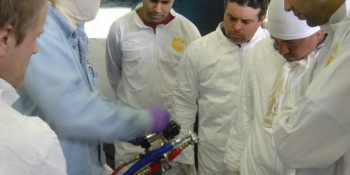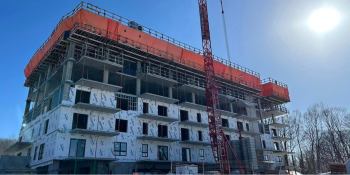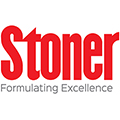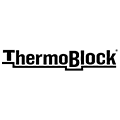Q&A Forums
Spraying Top Plate Technique Post New Topic | Post Reply
| Author | Comments |
|---|---|
|
Bob Sixberry
Posted: Feb 06, 2009 09:28 PM
|
Spraying Top Plate Technique
Hello, I have a client who has asked for sprayfoam on a house. The vendor is using 0.8 lb open cell and it looks and calculates out pretty well. The builder did not want to deal with open cell underneath the roof sheathing so the open cell was installed in a conventional fashion over the top floor ceiling sheetrock.One area that I saw which concerns me was the topplate. The builder did not use energy trusses and so there was limited space at between the roof sheathing & top plate area to insulate. The contractor did a poor job and did not spray the top plate at all, the insulation stops at the edge of the sheetrock. I suggested a few ways to fix the situation, and the vendor dug out and re-sprayed these areas. Unfortunately they still used building paper as a backstop to limit overspray and this paper was still attached to the inner side of top-plate. It looks like this may have to be sprayed from the outside before the soffit is put in. Are there any tips / simple techniques that can be used such that there is a insulation stop to the outside plate? Recognize the attic is completely sprayed with 8" of open cell foam, so access is difficult. Also with .8 lb foam the perm rating for walls and attic range from 4-7 perms. I don't believe that a moisture retarder is necessary as long as the drywall is fairly well sealed / caulked top and bottom. Thanks. |
|
mason
Posted: Feb 07, 2009 11:49 AM
|
Many folks use polystyrene board as an insulation block to spray foam to. This provides a little better stability than just construction paper. As for requiring a separate vapor retarder element. That would depend on the interior and exterior climate (temperature and humidity). Typically in mixed climates such as where I live in Virginia (near DC), a vapor retarder element is not required when using open cell foam in wall or ceiling applications. But as you go further north and vapor drives are more severe from the interior of the building to the outside, an additional vapor retarder element is desirable. Hygrothermal modeling would help you determine if there is a potential for condensation during the year and if there is a good potential for drying as well. Many folks use WUFI ( a software program developed and available from Oakridge National Labs) to make these determinations. You can also use the latest building code tables which list vapor retarders in 3 classes and which climate zones each can be installed. The new tables also list various combinations of insulation, vapor retarders and insulation sheathing that would work in the different climate zones. Hope this helps. and from our readers, let us know how you would resolve his problem. |
|
SprayFoamSupply.com
Posted: Feb 08, 2009 04:53 PM
|
Sounds like you are right and the area over the top plate will need to be sprayed from the outside. Could be messy if your contractor comes back. It could be a good use of the DIY kits. Alot of our guys use them for touchups such as this. George |
|
Bryan Kwater
Posted: Feb 10, 2009 02:36 PM
|
We use Accuvent baffles that cover the top plate and spray foam over them. |
|
Bob Sixberry
Posted: Feb 11, 2009 09:33 PM
|
I actually suggested using the accuvent system as a backstop. There is also the clip vent system which uses a compression based nailer that you can slip foam board on to provide a baffle, and the use a foam board as a backstop. The insulation contractor agreed that the top plate needed to be sprayed after my inspection, but after ripping out the foam in the area their crew used the same application methods as before with the same result. As far as moisture, this is upstate NY. I generally prefer a class 2 vapor retarder but the 5 perm rating isn't that bad. Also condensation in open cell foam typically is not that big a deal as long as it is diffusion based on not convection based. Just wanted some real world experience if possible. Thanks for all the suggestions. |





























